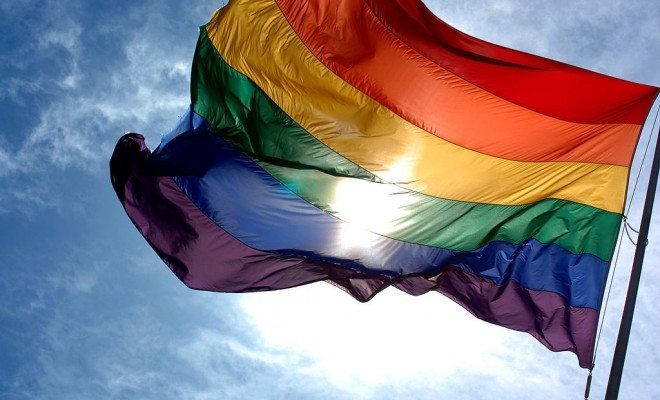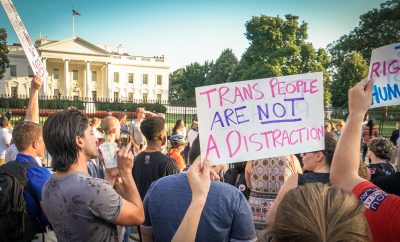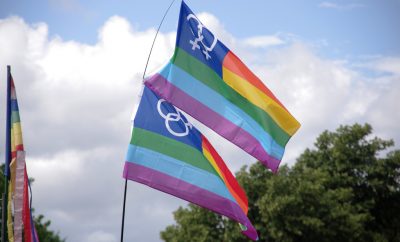
Society and Culture
Come Out, Come Out — and Go to Jail?
This Wednesday, October 11, will be the 25th Annual National Coming Out Day. Yay! A day devoted to all of us queers coming out of the closet and running around with reckless, rainbow abandon is super awesome, right?
I remember the first time I was actually out on National Coming Out Day. I was 17, and it was my senior year in high school. I had been coming out, bit by bit, for the last three years, and I was finally at a point in my life where literally everyone who knew me, knew that I was gay. I was also the president of my high school’s Gay Straight Alliance, which made it pretty much impossible to deny that I wasn’t a huge lezzer. So there was that.
Anyway! To honor the special occasion, me and all of my lovely, wonderful fellow GSA members wore purple that day—a sign of queer solidarity—and organized a bake sale. All of the proceeds went to the Matthew Shepard Foundation.
Now, there are tons of LGBT nonprofits we could have donated to. But we chose this particular one because, in October of 1998, Matthew Shepard was brutally attacked in Laramie, Wyoming. He died just in time for National Coming Out Day, making his organization an especially fitting one to benefit from our bake sale that year.
But what exactly is Matthew Shepard’s story, and how has he affected the LGBT community today? That’s a pretty complicated subject, so let’s settle into our rainbow-pride Snuggies and dive right in, mmkay?
In case you don’t already know the story, Matthew Shepard was a 21-year-old college student in Laramie, Wyoming. One night in October, two men abducted him from a local bar and drove him out into the rural, Wyoming night. They beat, robbed, and tortured him, leaving him tied to a fence to die. The next morning, a cyclist rode by, initially mistaking him for a scarecrow. Matthew was rushed to the hospital, but his injuries were too severe and he never woke up. He died on October 12, 1998.
The Matthew Shepard Foundation, which does lots of great work, was a direct result of Matt’s death. His mom, Judy Shepard, founded it with the goal of making the world a better and more accepting place, where people like Matthew won’t be harmed.
On that front, Matt’s legacy has affected us queers in a good way. He’s given us an organization that travels the country, spreading the noble message that it’s OK to be gay. He’s given us a poster child—unequivocal proof that it’s hard, and sometimes dangerous, to be queer. Perhaps most importantly, he’s given this country a vocabulary to talk about sexuality and violence. Those are all great things.
But. There have also been some not-so-great ramifications.
In 2009, the federal government passed the Matthew Shepard and James Byrd, Jr. Hate Crimes Prevention Act. It was meant to expand upon already existent hate-crime laws to include crimes motivated by gender, sexual orientation, gender identity, or disability. It was (and still is) a pretty big deal. Judy Shepard campaigned fiercely for its passage.
Now, at first glance, this little piece of legislation sounds awesome. It means that members of the LGBT community deserve to be valued and protected under the law. It sends a message to homophobic douchebags who want to hurt us—you won’t get off easy.
But, that’s just at first glance. Looking beneath the surface, the Shepard Byrd Act does more than just make prison sentences lengthier for gay bashers. It also funnels a whole lot more money towards state and local law enforcement agencies, and expands the policing power of the federal government.
In short, it makes the U.S.’ police state more powerful.
And you know who gets hurt the most by the U.S. police state? Queer people of color.
Since the 1980s, surveillance and policing in the U.S. have grown exponentially, with incarceration becoming the preferred method of dealing with economically and socially marginalized communities. Over these last 30 years, the U.S.’s federal prison population has risen by 790 percent, while crime rates have remained relatively stable. No other country in the world incarcerates more of its citizens than the U.S., and a disproportionate amount of those inmates are poor, queer, and/or of color.
But how can that happen? Surely, heterosexism, racism, and transphobia can’t possibly be an institutional part of our justice system. This is AMURRICA, the land of the free!
If only. While we’re prancing about in our rainbow, edible underwear for National Coming Out Day, let’s take a second to reflect on the origins of the annual Gay Pride Parade.
Gay Pride wasn’t a thing until 1969, when police raided New York’s Stonewall Inn. Back then, cross dressing was illegal, and if anyone was caught wearing fewer than three pieces of gender-conforming clothing, he or she (or ze!) would get arrested. That meant a ton of trouble for butch lezzies–identifiable by their dapper menswear–trans folks, and drag queens. And what happened if you got arrested for your gender-non-conforming attire? Likely, you’d get beaten and raped. Just ask Leslie Feinberg. This shit used to happen ALL THE TIME. (And it actually still does.)
Then, in 2003, Lambda Legal won the landmark case Lawrence v. Texas, which decriminalized homosexuality. That’s right, folks. It was ILLEGAL to be gay (or at least, to have super hot gay sex between two consenting adults) up until 2003.
I kid you not.
So basically, up until a measly 10 years ago, the cops were trained to arrest us. They were taught to see queer folks as criminals. They were encouraged to treat us with violence and contempt, because we were nothing but perverted delinquents. Historically, queers have had a really terrible relationship with law enforcement as a whole.
Nowadays, even though it’s no longer explicitly illegal to be queer, we’re still targeted. After all, old habits die hard, am I right? Cops routinely troll cruising spots, targeting gay men, they still raid our bars, beat and humiliate us, and they still rape us, all the goddamn time. And that’s just what happens to gay people. Imagine adding all of that targeted bias to issues of race and criminalization, or poverty, or gender variance. It gets so much worse.
Trans women of color know better than any of us what happens when you take all of that intersectional oppression into account–they’re routinely stopped by cops and arrested for solicitation or prostitution, based solely on racist, sexist, transphobic assumptions of criminality. Have you ever been accused of solicitation while you’re walking your dog? Probably not. This is a case of literal fashion police, except there’s no Joan Rivers and it’s not funny at all.
Not to mention, racism, sexism, and transphobia aren’t exclusive to the cops. Lots of people have less than warm and fuzzy feelings towards queers, and that makes it exponentially harder for us to get jobs. I’ve written about how difficult it can be for butch women to score employment, and that goes quadruple for trans people of color. With little or no opportunities for traditional employment, queers are often left with no other options besides sex work to support themselves. And of course, sex work is illegal.
So, to recap, poor queers of color are funneled into the prison industrial complex in two key ways: they’re unfairly targeted for arrest, and they’re forced into criminalized activities because of a lack of other viable options. Both of these realities are a result of racism, sexism, homophobia, and transphobia.
So you can see how it’s problematic that a piece of legislation, which is supposed to protect queer folks, actually strengthens an institution that specifically targets and harms us.
Because, ultimately, the cops aren’t using all that new money to find and punish white supremacists or gay bashers. More likely, they’re using it to harass, criminalize, and incarcerate poor people, queer people, and people of color.
Now, that’s not to say that all cops are bad, racist, homophobic pigs. Absolutely not. I’ve got an old friend whose father serves as a local Chief of Police, and I respect the hell out of him.
It is to say, however, that statistically, poor people, queer people, and people of color are targeted and harmed by the criminal justice system. As a result of that reality, funneling more money into that system is not a great strategy for protecting us.
But these facts often get ignored when we talk about Matthew Shepard. As a middle-class, gender-conforming, white man, his chances for having a run-in with the police were relatively small. No one would have stopped him while he was walking down the street and accused him of solicitation. Incarceration was not something Judy Shepard feared for her son.
And it’s no coincidence that Matthew became the gay hate-crime poster child. Many, many queer people have been violently murdered in the years before and after his death, and the majority of them were transgender women of color. Ever heard of Gwen Araujo? Probably not. And there’s a reason for that.
Reifying a white, cis-gender, middle-class gay man as the face of the LGBT community allows us to ignore the complex issue of intersectional, multifaceted oppression—where race, gender, sexuality, and class status are all inextricably linked.
So this National Coming Out Day, remember Matthew Shepard, but question the piece of hate crime legislation with his name attached to it. It’s not all it’s cracked up to be.
—
Hannah R. Winsten (@HannahRWinsten) is a freelance copywriter, marketing consultant, and blogger living in New York’s sixth borough. She hates tweeting but does it anyway. She aspires to be the next Rachel Maddow.
Featured image courtesy of [Ludovic Bertron via Wikipedia]








Comments